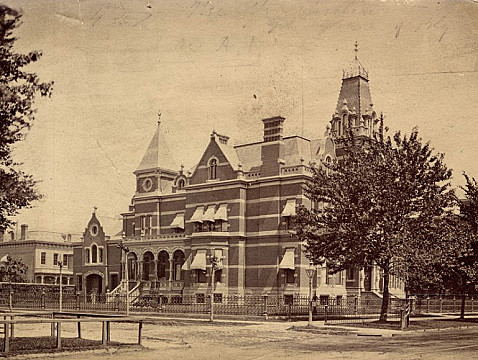Shelden Mansion
196 Fort Street West, Detroit, Michigan
Built 1875, for Allan Shelden (1832-1905) and his wife, Katharine Butler Dusenbury (1829-1916). This was among the grandest of the great mansions that once lined Detroit's Fort Street West. Designed by Gordon Lloyd, it is thought to have been an early influence on the central block of the Traverse City State Hospital (built 1885). The Shelden mansion was demolished circa 1920.

Allan Shelden Residence, Detroit
https://digitalcollections.detroitpubliclibrary.org/islandora/object/islandora%3A149307
Allan Shelden ran a wholesale dry goods firm with his business partner, Senator Zachariah Chandler (1813-1879), which became known as Allan Shelden & Co. when the latter died in 1879. His selection to the board of the Detroit National Bank cemented his position among the city's business elite. His wife (whose name is also spelt Catharine or Catherine) was the eldest daughter of Henry Richard Dusenbury (1801-1860), a wealthy lumber merchant of Portville, New York.
They commissioned Detroit's most celebrated architect of the time, Gordon W. Lloyd (1832-1905), to build them a sumptuous new family home on the site of - or very near to - the recently demolished farmhouse that had belonged to Senator Lewis Cass (1782–1866), Governor of Michigan. Lloyd blended brick with a cut stone finishing to produce a predominantly Elizabethan design, though the central tower with it's mansard roof was typical of Second Empire architecture.
A contemporary account in the Detroit Free Press described the mansion as containing, "countless rooms, each of which is fitted in superb style": These included the butternut hallway interspersed with ornamental panels, a music room, billiards room and a library of cherry-wood. The drawing-room, filled with treasures of art and sculpture, was decorated in the "American renaissance," with walls lined in delicate oriental silk under an "unusually rich frieze and decorated ceiling".
Even before the Civil War, Mrs Shelden had gained a reputation as one of fashionable Detroit's most popular hostesses. Her portrait that hung in the music room on Fort Street was donated to the Detroit Institute of Arts in 1985 by the widow of her great-grandson, Allan Shelden III (1916-1976). It was only shortly before her death that she left her home of forty years for Deeplands.
Shelden had died at the mansion in 1905, when it was left to their only child, Henry Dusenbury Shelden (1862-1941). Harry, as he was known, lived there with his society wife, Caroline Annette Alger (1865-1935), children, and widowed mother. But, having relinquished his role in dry goods back in 1890, it was now only his less time-consuming executive positions that tied him to city-life.
From 1911, the Sheldens (including his widowed mother) made their permanent home at Deeplands, Harry's recently completed country estate on Lake St. Clair in Grosse Pointe. The history surrounding the final chapter of their city mansion is as yet unclear, but it was not before long that it suffered the same fate as many like it and was demolished to make way for progress.
Categories
Styles
Share
Connections
Be the first to connect to this house. Connect to record your link to this house. or just to show you love it! Connect to Shelden Mansion →
